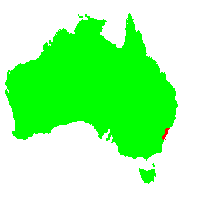General Description:
Syzygium is a genus of over 1000 species occurring in tropical and subtropical rainforests. There are about 50 species in Australia occurring in the Kimberly region of Western Australia, the Northern Territory, Queensland and northern New South Wales. The genus includes species previously classified in the genus Acmena as well as a number previously classified as Eugenia. The species formerly known as Eugenia australis is now regarded as two separate species, Syzygium australe and S.paniculatum.
Syzygium paniculatum is a shrub or small tree with flaky bark. The leaves are opposite (each pair emerges from the stem at the same location but on opposing sides), lance-shaped or elliptical in shape and bright, glossy green. White flowers appear in summer and are followed by large, fleshy, magenta-coloured fruits. These are ovoid in shape and around 20 mm long with a large seed. The fruits are edible and are often made into jams.
S.paniculatum is a reliable species in most temperate and subtropical climates. It prefers rich soils and assured moisture. An attractive form with variagated foliage is in cultivation. The species can be grown successfully in a large tub.
Propagation is usually carried out from fresh seed, either by sowing the fruits whole or after removing the flesh. Germination may be slow and spasmodic. The species can also be grown from cuttings of firm, current season’s growth.
* EPBC Act = Environment Protection and Biodiversity Conservation Act 1999;
ROTAP = Rare or Threatened Australian Plants (Briggs and Leigh, 1988)
For further information refer the Australian Plants at Risk page

A form of Syzygium paniculatum with variegated foliage
Photo: Brian Walters
 Australian Native Plants Society (Australia)
Australian Native Plants Society (Australia)












